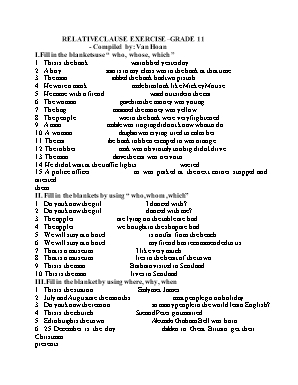Bài tập về nhà môn Tiếng Anh Lớp 11
Bạn đang xem tài liệu "Bài tập về nhà môn Tiếng Anh Lớp 11", để tải tài liệu gốc về máy bạn click vào nút DOWNLOAD ở trên

RELATIVE CLAUSE EXERCISE –GRADE 11 - Compiled by: Van Hoan I.Fill in the blankets use “ who , whose , which ” 1. This is the bank........................was robbed yesterday. 2. A boy........................sister is in my class was in the bank at that time. 3. The man........................robbed the bank had two pistols. 4. He wore a mask........................made him look like Mickey Mouse. 5. He came with a friend........................waited outside in the car. 6. The woman........................gave him the money was young. 7. The bag........................contained the money was yellow. 8. The people........................were in the bank were very frightened. 9. A man........................mobile was ringing did not know what to do. 10. A woman........................daughter was crying tried to calm her. 11. The car........................the bank robbers escaped in was orange. 12. The robber........................mask was obviously too big didn't drive. 13. The man........................drove the car was nervous. 14. He didn't wait at the traffic lights........................were red. 15. A police officer........................car was parked at the next corner stopped and arrested them. II. Fill in the blankets by using “ who, whom ,which” 1. Do you know the girl ........................ I danced with? 2. Do you know the girl ........................ danced with me? 3. The apples ........................ are lying on the table are bad. 4. The apples ........................ we bought in the shop are bad. 5. We will stay at a hotel ........................ is not far from the beach. 6. We will stay at a hotel ........................ my friend has recommended to us. 7. That is a museum ........................ I like very much. 8. That is a museum ........................ lies in the heart of the town. 9. This is the man ........................ Barbara visited in Scotland. 10. This is the man ........................ lives in Scotland. III.Fill in the blanket by using where, why, when 1. This is the station........................Emily met James. 2. July and August are the months........................most people go on holiday. 3. Do you know the reason........................so many people in the world learn English? 4. This is the church........................Sue and Peter got married. 5. Edinburgh is the town........................Alexander Graham Bell was born. 6. 25 December is the day........................children in Great Britain get their Christmas presents. 7. A famine was the reason........................so many Irish people emigrated to the USA in the 19th century 8. A greengrocer's is a shop........................you can buy vegetables. 9. The day........................I arrived was very nice. 10. A horror film was the reason........................I couldn't sleep last night. IV. Combine the sentences to relative clause 1. I gave you a book. It had many pictures. The book ..................................................................................................... 2. I am reading a book at the moment. It is very interesting. The book ...................................................................................................... 3. You live in a town. The town is very old. The town ...................................................................................................... 4. The sweets are delicious. I bought them yesterday. The sweets .................................................................................................. 5. The football match was very exciting. My friend played in it. The football match ..................................................................................... 6. The letter hasn't arrived yet. I posted it three days ago. The letter ................................................................................................... 7. He lives in a house. The house is not very big. The house .................................................................................................. 8. They are playing a song on the radio. Do you like it? Do you like ............................................................................................... 9. Jane wore a beautiful shirt yesterday. Did you see it? Did you see ........................................................................................... 10. Sue is going out with a boy. I don't like him. I don't like ............................................................................................. 11. Samuel Johnson was the son of a bookseller. Samuel Johnson was born in 1709. Samuel Johnson ...................................................................................... 12. In 1728, he went to Oxford. He studied at Pembroke College in Oxford. In 1728, he went ....................................................................................... 13. Johnson had to leave Oxford without a degree. He was too poor to pay the fees. Johnson ...................................................................................................... 14. In 1737, Johnson moved to London. There he wrote poetry, essays and biographies. In 1737, Johnson ......................................................................................... 15. In 1746, Johnson started to write his dictionary. It took him nine years to complete. In 1746, Johnson started ............................................................................. 16. His home at that time was in 17 Gough Square in London. It is a museum now. 17 Gough Square in London ....................................................................... 17. In this house, his wife died in 1752. Her name was Elizabeth Porter. In this house his wife ................................................................................................ 18. In 1755, the work was published. It was called A Dictionary of the English language. In 1755, the work ....................................................................................... 19. Samuel Johnson died in 1784. He is buried in Westminster Abbey. Samuel Johnson ............................................................................................ 20. That is the girl . Her father sits next to me at school. That is the girl - THE END -
Tài liệu đính kèm:
 bai_tap_ve_nha_mon_tieng_anh_lop_11.docx
bai_tap_ve_nha_mon_tieng_anh_lop_11.docx





